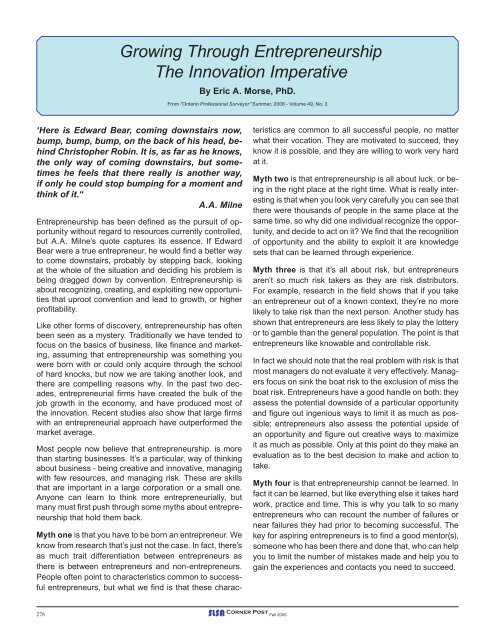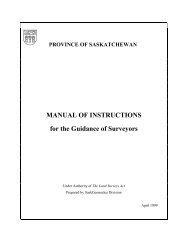Fall - Saskatchewan Land Surveyors Association
Fall - Saskatchewan Land Surveyors Association
Fall - Saskatchewan Land Surveyors Association
- No tags were found...
You also want an ePaper? Increase the reach of your titles
YUMPU automatically turns print PDFs into web optimized ePapers that Google loves.
Growing Through EntrepreneurshipThe Innovation ImperativeBy Eric A. Morse, PhD.From “Ontario Professional Surveyor” Summer, 2006 - Volume 49, No. 3‘Here is Edward Bear, coming downstairs now,bump, bump, bump, on the back of his head, behindChristopher Robin. It is, as far as he knows,the only way of coming downstairs, but sometimeshe feels that there really is another way,if only he could stop bumping for a moment andthink of it.“A.A. MilneEntrepreneurship has been defi ned as the pursuit of opportunitywithout regard to resources currently controlled,but A.A. Milne’s quote captures its essence. If EdwardBear were a true entrepreneur, he would fi nd a better wayto come downstairs, probably by stepping back, lookingat the whole of the situation and deciding his problem isbeing dragged down by convention. Entrepreneurship isabout recognizing, creating, and exploiting new opportunitiesthat uproot convention and lead to growth, or higherprofi tability.Like other forms of discovery, entrepreneurship has oftenbeen seen as a mystery. Traditionally we have tended tofocus on the basics of business, like fi nance and marketing,assuming that entrepreneurship was something youwere born with or could only acquire through the schoolof hard knocks, but now we are taking another look, andthere are compelling reasons why. In the past two decades,entrepreneurial fi rms have created the bulk of thejob growth in the economy, and have produced most ofthe innovation. Recent studies also show that large fi rmswith an entrepreneurial approach have outperformed themarket average.Most people now believe that entrepreneurship. is morethan starting businesses. It’s a particular, way of thinkingabout business - being creative and innovative, managingwith few resources, and managing risk. These are skillsthat are important in a large corporation or a small one.Anyone can learn to think more entrepreneurially, butmany must fi rst push through some myths about entrepreneurshipthat hold them back.Myth one is that you have to be born an entrepreneur. Weknow from research that’s just not the case. In fact, there’sas much trait differentiation between entrepreneurs asthere is between entrepreneurs and non-entrepreneurs.People often point to characteristics common to successfulentrepreneurs, but what we fi nd is that these charac-teristics are common to all successful people, no matterwhat their vocation. They are motivated to succeed, theyknow it is possible, and they are willing to work very hardat it.Myth two is that entrepreneurship is all about luck, or beingin the right place at the right time. What is really interestingis that when you look very carefully you can see thatthere were thousands of people in the same place at thesame time, so why did one individual recognize the opportunity,and decide to act on it? We fi nd that the recognitionof opportunity and the ability to exploit it are knowledgesets that can be learned through experience.Myth three is that it’s all about risk, but entrepreneursaren’t so much risk takers as they are risk distributors.For example, research in the fi eld shows that if you takean entrepreneur out of a known context, they’re no morelikely to take risk than the next person. Another study hasshown that entrepreneurs are less likely to play the lotteryor to gamble than the general population. The point is thatentrepreneurs like knowable and controllable risk.In fact we should note that the real problem with risk is thatmost managers do not evaluate it very effectively. Managersfocus on sink the boat risk to the exclusion of miss theboat risk. Entrepreneurs have a good handle on both: theyassess the potential downside of a particular opportunityand fi gure out ingenious ways to limit it as much as possible;entrepreneurs also assess the potential upside ofan opportunity and fi gure out creative ways to maximizeit as much as possible. Only at this point do they make anevaluation as to the best decision to make and action totake.Myth four is that entrepreneurship cannot be learned. Infact it can be learned, but like everything else it takes hardwork, practice and time. This is why you talk to so manyentrepreneurs who can recount the number of failures ornear failures they had prior to becoming successful. Thekey for aspiring entrepreneurs is to fi nd a good mentor(s),someone who has been there and done that, who can helpyou to limit the number of mistakes made and help you togain the experiences and contacts you need to succeed.278 SLSA Corner Post <strong>Fall</strong> 2006













